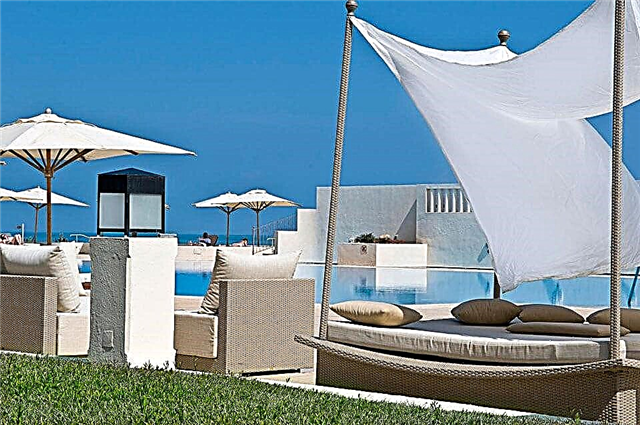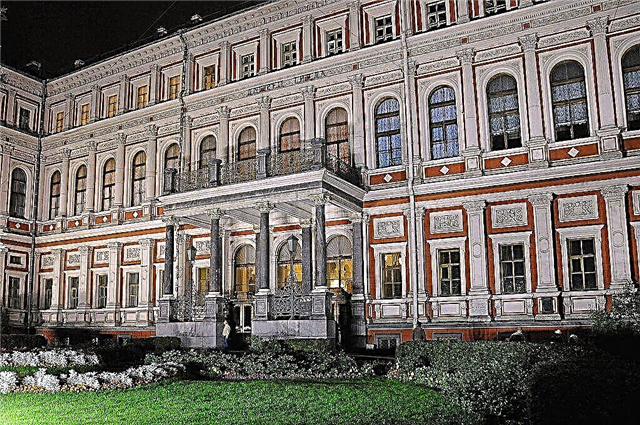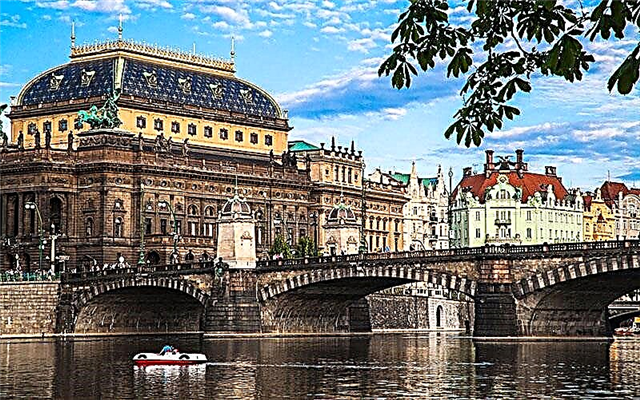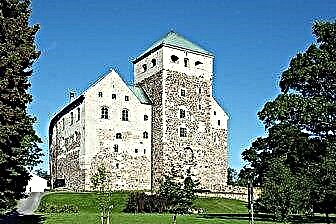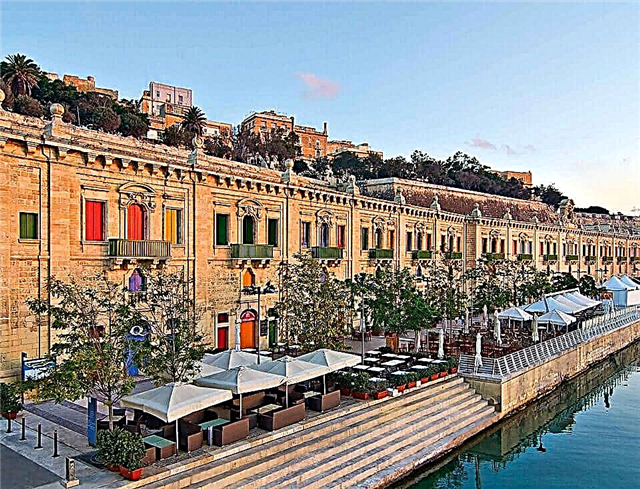Why, after visiting this Mediterranean city, many begin to believe in ghosts, is it only the atmosphere? Everything here is shrouded in secrets, reminds of amazing artifacts, outstanding personalities who made the history of Europe and, undoubtedly, the Hospitallers. The sights of Valletta seem to live their own special life, the mysteries of the city attract historians, archaeologists, and numerous tourists. Every day in August, the apparition of the ghost of the White Lady - either the beloved or the daughter of the founder of the city - is expected here, and, interestingly, they see a girl in a light dress walking through the streets. Valletta has never been a peaceful place on earth. Life and death, love and hate went hand in hand. The island constantly became the arena of hostilities. And yet, the townspeople managed to maintain their special chivalrous attitude to life, when every day is filled with the service of high ideals.
Republic Square

The small square traditionally attracts tourists, lovers of relaxation in open-air cafes and restaurants. The Maltese changed its name several times. In historical chronicles this place was first mentioned as "Treasury Square". The site of any city where the funds of religious orders were kept in the Middle Ages was a special place.
It was guarded as a royal palace (in some cases and better). It was on such a square where the Hospitallers' treasury was kept that the house of the National Treasury was erected. It also has one more name - Royal. Here at the end of the 19th century, a monument was erected to the British Queen Victoria, who allowed the revival of the Order of Malta in Great Britain.
Formally, members of the crowned family are not hospitallers, in fact, they patronize the Johannites to this day. There is another famous landmark on the square - the National Library of Malta. The beginning of the construction of the building dates back to the 16th century; it is a kind of neoclassicism standard and sets the general tone for the architectural ensemble.
Grand Master's Palace

Historians date the construction of the palace to the 16th century. These were originally barracks. After a major overhaul, they turned into a luxurious palace. Outwardly, it looks modest in comparison with similar European architectural structures, but the inside amazes with luxury, interesting style solutions. The palace was the official residence and residence of 21 leaders of the Order of Malta.
Each of the Grand Masters, who headed the military-religious association, contributed to the appearance of new masterpieces of art in the palace halls. Later, the building was occupied by the Government of Malta, local authorities and today owns part of the premises that are closed to tourists. However, the rooms open to the public are enough to get an idea of the splendor of the palace, among the relics of which there is a lifetime portrait of Catherine the Great.
The building houses a unique collection of weapons. Those who are little interested in military history visit the site to admire its floor mosaics, wall and ceiling frescoes. On the territory of the palace there are two cozy courtyards, where the atmosphere of antiquity also reigns and there is a feeling: soon one of the former masters of the order will go down to the fountain to reflect on the eternal.
Castile courtyard

It is hard to imagine that an old three-story Baroque mansion is an inn. Such establishments in Malta were not intended for the common people, but rooms for servants in the house are provided. The buildings were “assigned” to the association of Knights Hospitallers, who did not have their own castles or houses. The soldiers served the Order of Malta, and he took care of them.
The association, to which this courtyard was listed, served on the bastion of St. Barbara. The house, erected in the 16th century, hospitably opened its doors for representatives of the clergy and pilgrims. The mansion is located on a hill with a magnificent view of the city. The owners of the courtyard have changed over the past 250 years.
The house was rebuilt after the hostilities, it was bombed during World War II and miraculously survived. At the moment, the residence of the Prime Minister of Malta is located here. Tourists gather near the courtyard to watch the changing of the guard of honor, admire the decor of the building and the nearby fountain.
Casa Rossa Piccola Palace

The main value of the structure: it was practically not rebuilt and remained in its original form. The likely reason for this: the palace has been owned by the aristocratic de Piro family for 400 years, whose representatives care about the historical heritage. Today, the owners of the building are happy to host excursion groups.
De Piro are one of the richest Maltese, whose museum (located in the palace) is known all over the world, but they are devoid of arrogance and snobbery. Representatives of the aristocratic family gladly conduct excursions, show antiquities, masterpieces of painting, underground passages leading to bomb shelters. For local residents, communication with tourists on the territory of their private estates is commonplace. The funds received from the excursions go to charity and the preservation of monuments.

Maltese millionaires, billionaires are not shy about such sources of income, they are proud of their history. At various times, the palace was rented by the Hospitallers, who made an outstanding contribution to church life, the strengthening of law and order, the creation of a banking system on the skeleton. In the museum you can see things that belonged to famous guests of Casa Rossa Piccola.
Jesuit Church

The oldest temple in the city was founded at the end of the 16th century. This event could have happened earlier, but, due to various circumstances, the construction was postponed. Initially, the Jesuit order planned to locate a college and a small church on this site. As a result, the temple and the building of the educational institution occupied an entire quarter, making up a single harmonious architectural ensemble.
Over time, the status of the Jesuit institution changed, its leadership began to pay attention to scientific work. At the present time, the building of the college houses the University of Malta, where 10 thousand students from all over the world study. The exterior of the temple is a striking example of the Baroque style. The interior is in harmony with it, however, it was created according to the canons of a more strict classics, reminiscent of ancient buildings.
When looking at the church and college, tourists have the feeling that they are seeing a fortress. This is natural: an explosion occurred here in the 17th century, after which the reconstruction of buildings was carried out on the model of military fortifications so that buildings in case of danger could become an additional line of defense.
City gate

Putiryal is one of the symbols of Valletta and Malta. The architecture of the building is simple and functional. Unfortunately, the gate has not been preserved in its original form. The architectural monument, included in the list of UNESCO World Heritage Sites, is the result of several reconstructions. The gate was erected in the 16th century, and a wooden drawbridge was attached to it.
In the middle of the 19th century, Putiryal was rebuilt, then the building began to decay. The gate was seriously damaged by the bombing of German aircraft during the Second World War. Scandals flared up several times around the reconstruction of the city's symbol in the 20th century. In the 60s, local authorities were inclined to give the building a modern look, which the Maltese public received with hostility.
After discussions, meetings of commissions, fundraising and specialists, the reconstruction of all four main city gates (of which Putiryal is a part) began only in the 21st century. The use of new technologies for the restoration of unique monuments, according to the Maltese authorities, will maximally protect them from the destructive effects of the sun, wind, and humid air.
Argotti Botanical Garden

The landscape monument borders on St. Philip's Garden. Both gardens date back to 1741 and owe their origins to the Grand Master of the Pinto Hospitaller Order. The prominent politician was a connoisseur of exotic plants. In the gardens he founded, there are unique collections of cacti and medicinal herbs. Argotti is famous for its fountains and gazebos. On its territory there are ponds, water towers.
Tourists head to the garden to admire rare plants. It is noteworthy: even the Maltese themselves find it difficult to draw the exact boundaries between the gardens of Argotti and St. Philip due to the fact that significant changes have been made to the layout of landscape monuments several times. It is known for certain: most of the fountains were built before the laying of both gardens. The luxurious rose garden is definitely part of St. Philip's garden, and the gardening museum is Argotti.
Church of Our Lady of Lesse

The construction of the building began in 1620. The temple was built at the expense of the descendants of the Lusignan dynasty. Representatives of this family became famous during the time of the Crusades for their unbridled desire for power, love of luxury, terrible crimes and deeply pious deeds. The closeness of the church to the harbor and the local market influenced the class composition of the parish: it was mainly visited by merchants and sailors.
The original appearance of the building has not been preserved: after 100 years, significant changes were made to its architecture, and the baroque canons began to dominate in the exterior. The church was badly damaged during the Second World War, but the Maltese saved the unique building from destruction. The main temple relics is the statue of the Virgin. Believers believe: the sculpture was created by angels 1000 years ago. The statue appeared in response to the prayers of the three Hospitaller Knights.
Those needed to show the daughter of the Sultan the image of the Virgin Mary. The Blessed One heard the prayers of the Johannites, and a miraculous statue arose right in front of the knights and the girl (who later converted to Christianity). Another no less famous temple relic: the relics of the Martyr Saint Jeronese. A mystical story is also associated with them: the French occupying the island repeatedly tried to take out the shrine, and the ships heading for this purpose sank for no apparent reason right off the coast of Malta.
National Museum of Archeology

The old mansion on Republic Street, where the museum is located, is itself an amazing monument of history and architecture. The building was built in the 16th century, its architecture is dominated by the Baroque. Thick stone walls, strategically convenient location suggest that the Hospitallers (if necessary) could rebuild the house in the shortest possible time, turning it into a small fortress. Before the museum, the Union Club operated here.

This institution, where the issues of the island's life were resolved, was founded by the British when Malta was under the protectorate of Great Britain. The mansion was transferred to the museum at the end of the last century. The search for buildings suitable for archaeological collections has been lengthy. It was required to ensure the protection of artifacts from criminals who periodically manage to penetrate the island in order to hunt for the relics of the Hospitallers.
On the other hand, a suitable temperature regime was required to store antiques. The mansion was the perfect solution. In it today you can see unique things, whose age is more than 5000 years, weapons, jewelry, items of church utensils found at the Maltese excavations, elements of the decoration of buildings and much more.
Church of St. Francis

The Catholic church dates back to the end of the 16th century. In the last century, the building was thoroughly rebuilt, it had a different dome. Not without mysticism in the appearance of a new temple on the territory of Malta. The first building began to collapse even before the completion of construction. Historians explain this fact as follows: during the construction of the structure, the Hospitallers made gross mistakes.
This is controversial, because the Johannites had an excellent command of the latest (for that time) methods of stone processing and performing engineering calculations. More than 70 years have passed, and no one dared to disturb the ruins of the temple. Grigorio Carafa, who at that time led the order, allocated funds for the restoration of the church, promising to install a miraculous statue of Francis of Assisi in it.
The second time everything went well, and in memory of the event, the Maltese placed the coat of arms of the Grand Master Karaf on the facade of the temple. Today, Christian pilgrims from all over the world come to church to see the statue of the saint and attend Mass. Old frescoes have been partially preserved in the building. Among the most famous relics of the temple: paintings by famous Italian Renaissance artists dedicated to biblical subjects.
National Library of Malta

The library was founded in 1776, but the bulk of the collection was collected 100-150 years earlier. At the origins of the unique collection were libraries of famous European feudal families that were transferred to the ownership of the Hospitallers even earlier. It is noteworthy: after the death of each John, the manuscripts, documents, books belonging to a knight or a lady entered the treasury of the Order of Malta.
To some, such an approach today will seem excessive formalism, but it was he who helped preserve rare European editions in those days when manuscripts (like people) were burned at the stake for only suspicion of heresy. The library has been occupying the current building on Republic Square since 1812. It contains over 60 thousand books, manuscripts, folios, unique documents. Prior to this, the library collections changed their location several times.
The greatest damage to the collection was caused by Napoleonic soldiers: during the occupation of the island, they deliberately destroyed the documents of the Hospitallers in order to erase the memory of the past masters of Malta in this way. The library received its current status in the 70s of the last century. The entrance is free. There is a cafe in the building, where there is an exhibition dedicated to the history of the Hospitallers.
Church of Our Lady the Victorious

The very first building in the city is located in a mystical place. It is here that the first stone is located, from which the construction of Valletta began. The liberation of the island from the invasion of the huge army of the Ottoman Empire was considered impossible in the 16th century. The knights perceived their victory over the Turks as a miracle and explained it with only one thing: the heavenly patronage of the Virgin Mary. In honor of the Most Pure, it was decided to build a temple. There are legends: the enormous wealth of the Johannites is hidden in the church foundation.
They contradict historical evidence of how the Hospitallers laid their personal awards in the foundation of the building for courage shown in battles and messages to future generations of knights. The founder of the city, Grand Master of the Order of Malta, Jean Parisot de la Vallette, was buried in this temple. Later, his remains were transferred to the cathedral. The spirit of the founder of the city, according to the mystics, periodically appears near the Church of Our Lady of Victory.
The Maltese believe: the will of the master is still violated, because his ashes are in another place. In the late 17th - early 18th centuries, significant changes were made to the architecture of the church, ceiling frescoes and new altars appeared in it. Since that time, the external and internal decoration of the temple has become fully consistent with the canons of the Baroque and acquired stylistic completeness.
Manoel Theater

The oldest theater in Europe has often changed its name. The history of the institution, built in the first half of the 18th century, is full of unexpected twists and turns. During World War II, the building was damaged, but it survived. The Maltese, who were left homeless due to the bombing, saved their lives there. During the war years, the theater was reconstructed in record time, even for peacetime. The fighting failed to destroy the Maltese's love for music.
She inspired the townspeople to do the impossible: to return the aristocracy and respectability to Valletta, when bombs flew into the city every day from German planes. Most of the elements of the theater's decor are originals created in the 18th century, including luxurious Viennese chandeliers. White marble of the main staircase, green velvet draperies, gilded elements, frescoes create a unique atmosphere inside the building.
The theater hall has a capacity of 600 seats and is distinguished by excellent acoustics. The stars of the world stage are considered an honor, a rare success of performing on this stage. The theater has its own museum, which houses rarities related to the history of the development of art in Malta.
Fort St. Elmo

The Christian martyr, after whom the fort and the island are named, is the patron saint of seafarers. Historians and archaeologists date the construction of the first fortifications of the fort to the XIV century. After 200 years, Malta was captured by the Turks. The Knights Hospitallers conquered the fortress and, first of all, began to restore the walls and underground communications. It was here that they built a tower (there are versions that they reconstructed) for the lighthouse.
Nowadays, a police academy, a military museum operate on the territory of the fort, and costume performances are regularly held. Fort Saint Elmo went down in the history of the state as the site of the rebellion of the priests. The new Grand Master after the reign of his predecessor (the latter was an influential European politician, close friend of the famous adventurer Count Cagliostro) found that the order's treasury ... empty, and under the pretext of austerity raised food prices.
This caused discontent among the people. The uprising was led by priests who decided to get rid of the Johannites. An armed crowd captured part of the fort, its leaders threatened to blow up powder depots. The uprising was suppressed, but this was the first bell, heralding the end of the unlimited power of the Hospitallers over the island.
Upper Barrakka Gardens

Initially, the park was intended exclusively for the Knights of St. John. The terraces that make up the garden were built in the 18th century. They offer city and harbor views. Originally, each terrace had a roof. The structures were removed after 100 years for safety reasons - to monitor the appearance of strangers in the gardens from a height.
The knights did everything possible to maintain their power over the island, but they did not foresee the Napoleonic occupation and the new life of Malta after it. Since 1800, after the island was rid of the French, the park began to operate according to new rules (they would have shocked the previous leadership of the Hospitallers). Local authorities have opened the gardens to the public. Later, monuments to foreign politicians, including Winston Churchill, appeared here.
Among the famous sights of the park was a sculpture of a literary character: not a noble knight, but a Parisian street child Gavroche. Later, an elevator appeared in the gardens. New monuments, technical advances have given the ancient terraces additional comfort, turning them into a popular vacation spot for tourists and townspeople.
Fireworks battery

One of the most famous Maltese landmarks is the row of cannons installed along the wall. The approximate age of the defensive structure: 500 years. However, the fortifications themselves were erected earlier. Every year for two centuries, at noon, a cannon shot is fired. Once upon a time, the Maltese checked their watches. These days it is more of a tribute to tradition and a way to attract tourists.
The daily cannon shot is preceded by a colorful mini-show featuring actors in vintage costumes. It is accompanied by a short lecture on the history of the city and the island. The second daily shot is fired at 16:00 local time. This ceremony looks much more modest, but it is more reliable from a historical point of view.
Situational Center Laskaris

The bunker is located under the Upper Barrakka gardens. Previously, the center of Laskaris was a highly classified facility. Today it is open to the public and serves as a museum dedicated to World War II, the confrontation between the Soviet Union and NATO. Initially, the headquarters of the British command was located here. The leadership of the military operations of the countries participating in the anti-Hitler coalition was carried out precisely from this bunker.

In the 60s, the facility was considered the property of NATO troops, but it is likely that the military rented it and then transferred it to the local authorities. The enterprising Maltese have turned the bunker into a famous city landmark. Next to it is the building of the former NATO headquarters, which is also part of the museum complex. The latter also includes several other objects: a crypt, a chapel, and a fireworks battery. The Situation Center houses a café and an antique shop popular with European collectors.
Toy Museum

The exposition occupies 3 floors of an old mansion, where an amazing cozy atmosphere, reminiscent of childhood, reigns. The museum was opened at the end of the last century, but the history of the private collection of Vincent Brown (its founder) began in the 80s. In Europe, it is not customary to throw away old toys. Such things are changed, sold at flea markets, given to friends. One day a family friend gave the Brown children a box of his cars.
Vincent decided to repair the toys, and his collection began with them. Its main part is made up of miniature models of typewriters. They, along with toy airplanes and boats, occupy the first floor of the mansion. Among the museum's rarities: pre-war toys, animal figurines, tin soldiers. In order not to deprive the attention of young visitors, Brown specially collected a collection of dolls from around the world.
Hastings Gardens

The park area, according to local legends, was created in just a few hours. This is undoubtedly fiction, but it is he who perfectly reflects the self-esteem of the Maltese and pride in unique attractions. The gardens are named after the Governor of Malta, who was fond of gardening. They are located on the bastions of St. Michael and St. John - previously completely unsuitable for planting trees, shrubs, flowers.
In the 19th century, Hastings developed a plan for the improvement of sites, acquired seeds and seedlings with his own funds and was able to achieve success: the plants planted by his order transformed the bastions familiar to the Maltese. The ashes of the governor rests in the park, where a monument is erected to him - a tribute to his relatives. There was a period in the history of the gardens when they fell into decay, but the local authorities invested in the reconstruction of the park and saved the recreation area. The gardens are known for their collections of statues and exotic plants. They have an atmosphere conducive to leisurely walks and contemplation.
Fountain Triton

Even the most conservative Maltese call one of the most famous city fountains a symbol of the republic. It is with him that many excursions begin. The building is located next to the city gates, striking with a harmonious combination of grace and monumentality. The fountain is not a monument of antiquity, but it fits perfectly into the architecture of Valletta.
The fountain was officially opened at the end of the 50s of the last century. After about 20 years, the structure required an urgent major overhaul. The organizers of the music festival were "smart enough" to set the stage right on the bowl of the fountain.The holiday was wonderful, but positive reviews about it were soon replaced by the anger of the townspeople, who learned that the local landmark was damaged.
The restoration work was completed 9 years after the accident and gradually became the subject of jokes among the Maltese. The fountain symbolizes the water element for the inhabitants of the island, the intercession of higher powers. In the center of the amazing structure is the figure of Triton (the son of the main sea god - Poseidon). 98% of the Maltese are deeply religious Catholics, which does not prevent them from admiring the beauty of the sculpture of an ancient deity.
St john's cathedral

The Catholic Church in honor of the patron saint of the Order of the Hospitallers has been perfectly preserved since its construction in the 16th century. The exterior of the building remained the same, the only thing: its interior after 100 years has become even more luxurious and began to correspond to the canons of the Baroque. Outwardly, the cathedral resembles a military fort, which is quite natural for ancient Maltese buildings.
The exterior of the temple looks imposing and austere, enhancing the impression of the stunning splendor of its interior decoration. The main part of the building is shaped like a rectangle. There are 13 chapels around it. At the time of the decoration of the walls of the temple, artists did not know 3D technologies and still managed to achieve the effect that the figures in the images looked three-dimensional. An important part of the cathedral are the tombstones with the names of the valiant Knights Hospitallers.
A museum and an art gallery are attached to the main building, which houses the masterpieces of spiritual painting that belonged to the Order of the Johannites. Numerous paintings and sculptures by Italian Renaissance masters create a mesmerizing atmosphere. Each element of the decor in the temple can be examined for hours, forgetting about the time.
Museum of Fine Arts

The mansion of the 16th century, where the museum is located, belongs to the group of the oldest buildings in the city. At different times, famous European commanders, politicians, and representatives of the clergy lived here. The building was rebuilt several times; historians can only judge about its original appearance from the surviving engravings. The mansion acquired its current appearance about 250 years ago, at the same time its exterior began to correspond to the Rococo canons.
The building once housed a theological seminary, housed the command of the Maltese fleet, and received citizens from city officials. In the 70s of the last century, the mansion was reconstructed, at that time a new museum was opened in it. Its collection was originally part of the National Archaeological Museum. The basis of the unique collection was created by the world-renowned art critic Vincenzo Bonnelo.
He spent huge sums of money on the acquisition of masterpieces of world culture. The pearls of his collection were the works of Caravaggio, Perugino, and other Italian masters who worked during the Renaissance and at the dawn of the heyday of realism in European art. In the museum you can also see collections of Sicilian furniture, majolica, where each item is made in a single copy.
Memory bell

The modern monument, also called the Siege Bell, is located on a cliff. Its strict columns are crowned with a roof. The memorial outwardly resembles an open antique gazebo or a place of worship for the spirits of the winds (similar structures were erected here long before Christianity). It was built at the end of the last century in memory of the Maltese, whose lives were taken by the Second World War.
The republic was part of the anti-Hitler coalition, German aviation constantly bombed Valletta. On the battlefields, about 8 thousand Maltese died in the city. And thousands more of the Knights Hospitallers were killed in concentration camps along with the Jews. The order was indirectly involved in the attempts on Hitler's life and, in spite of everything, provided medical and food assistance to the population of the territories occupied by the Germans.
The bell rings daily at noon. At this time, many Maltese interrupt business and read prayers for the dead. Not far from the monument is a statue of a soldier covered with a banner - another reminder of the war.
Lower Barrakka Gardens

The city park on the Bastion of St. Christophe is similar in appearance and layout to the gardens of the Upper Barrakka. One of the most beautiful places in Valletta is both an architectural and landscape monument created in the 19th century. The Lower Gardens are perfectly visible from the Upper Gardens, which allows you to admire the splendor of the former without going down to other levels.
The Lower Garden contains a large number of fountains, miniature artificial reservoirs, and various sculptures. It houses a collection of rare Mediterranean and exotic plants. Among the famous attractions of the park: the monument to Sir John Ball. The great naval commander, diplomat led the uprising of the Maltese against the Napoleonic troops.
He helped the island to become part of the British Empire, was the governor of Malta, invested his own funds in its revival and did much to restore Valletta after its barbaric plunder by the French. The buildings on the territory of the gardens outwardly resemble ancient temples. Its terraces offer views of the city, the harbor, the Bell of Memory. The park is relatively uncrowded; it is preferred mainly by lovers of secluded walks.
The embankment

The favorite vacation spot of townspeople and tourists seems to have been specially created for entertainment for every taste. This section of the city was first landscaped more than 300 years ago by the forces of the Hospitallers. He is great at any time of the day. There are bars, cafes, restaurants everywhere, where you can taste Mediterranean cuisine.
Numerous shops, souvenir shops offer literally everything: from elite spirits, exotic fruits, handmade chocolate - to miniature copies of the Johannite ships and antiques. All buildings on the embankment are a single architectural complex. Many of its buildings were destroyed during the Second World War and then restored to their original form.
The embankment is a popular venue for international, republican holidays, including the famous jazz and fireworks festivals. At Christmas and Easter, grandiose religious ceremonies take place here. The embankment can be compared to a reflection of the very spirit of the city, where antiquity and the present day peacefully coexist with each other.


